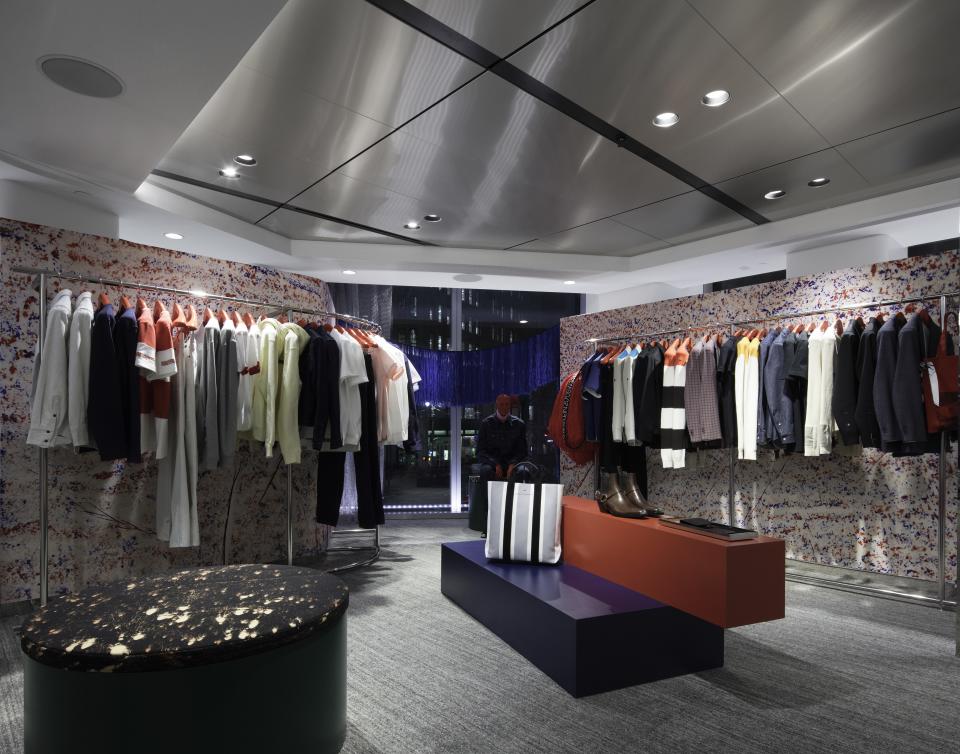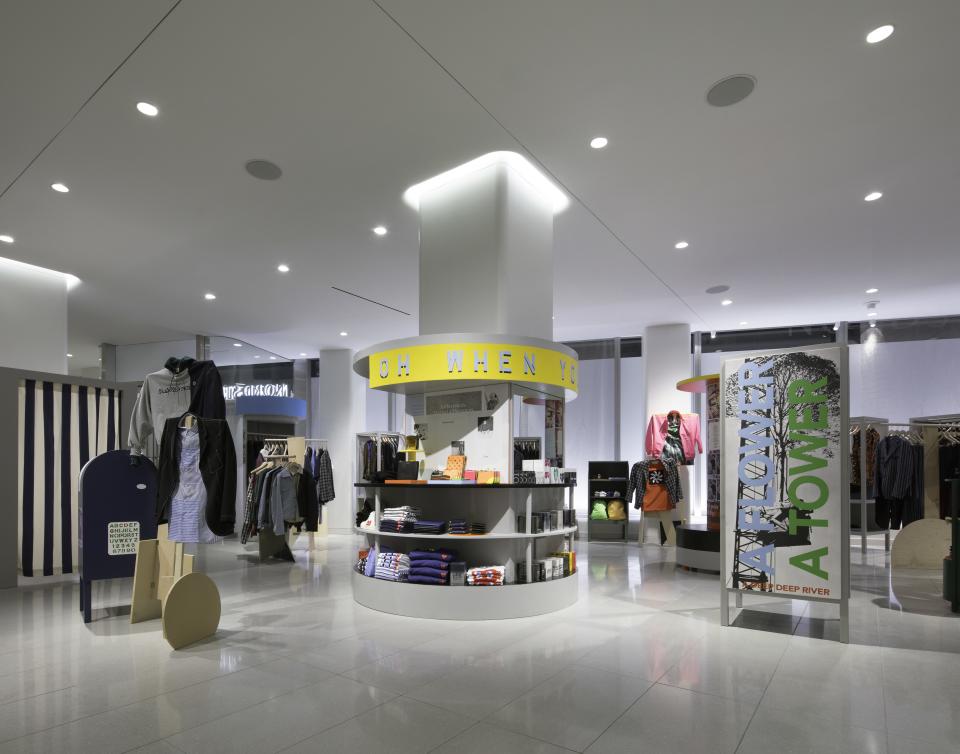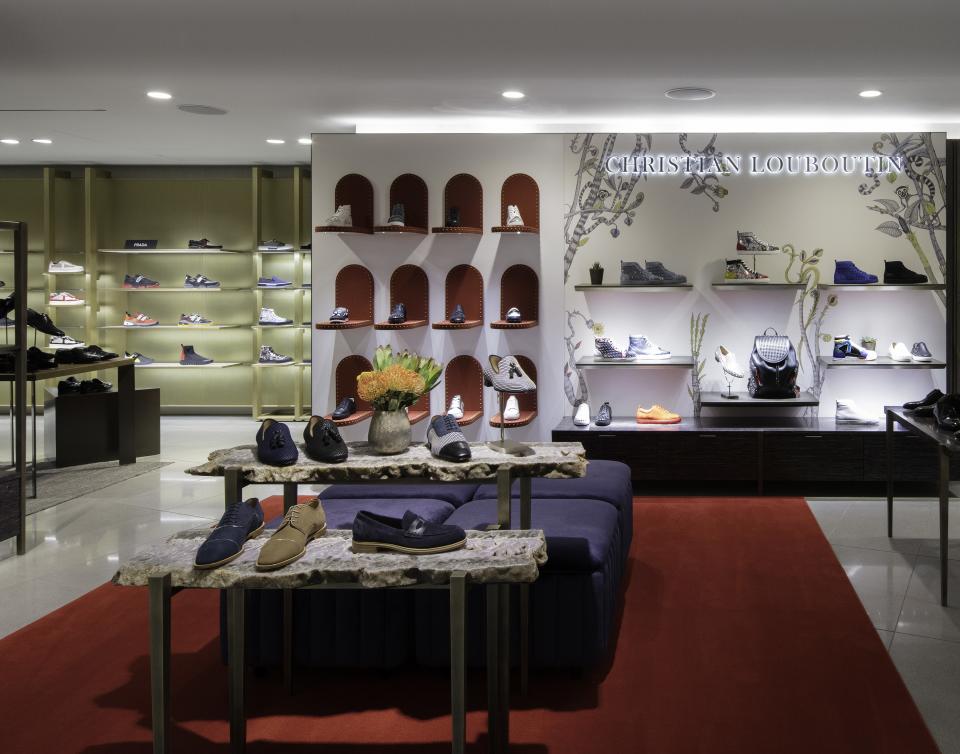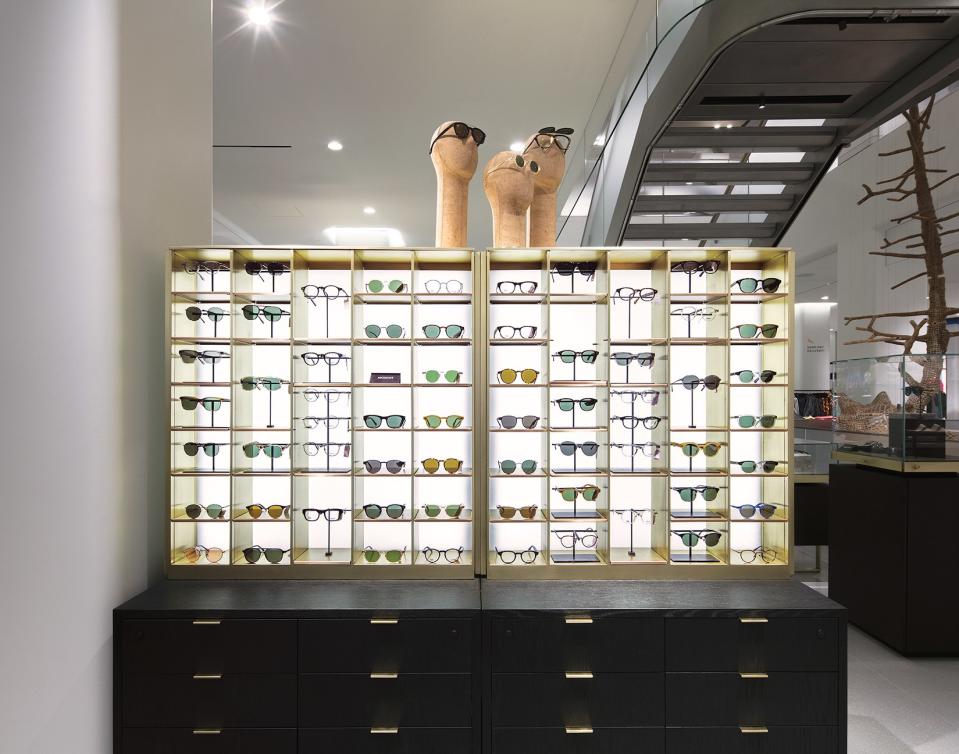Nordstrom's New York Store Is Like Shopping Online—Only in Real Life
The Fisk Building, at the corner of 57th and Broadway, was erected in 1921 to house tire makers. A Walgreens now dominates the ground floor; until recently, a muffin shop and a couple of bank branches sat across the street. Now, there’s a newcomer to this small slice of New York’s relentless retail churn: Nordstrom, the 117-year-old department store, is opening in a three-story 47,000 square-foot space. And it’s doing so at a said-to-be cataclysmic time for department stores. To cite one example: last year, Lord & Taylor sold off its space—so iconic it’s registered as a New York landmark—to WeWork. That’s just one of the many grim headlines that can make Nordstrom’s decision seem like a colossal miscalculation. But what Nordstrom’s been able to do relative to its competition—in short: keep moving forward, and even turn a profit—suggests that it might turn even a tricky New York lease into a success.
The new men’s-only Nordstrom (the women’s store across the street won’t open until fall 2019), opening today, immediately makes a statement. Nordstrom’s executives believe that shoppers in New York are more fashion-forward than anywhere else in the world, so its hits visitors in the mouth with fashion: the first thing entrants to the store find is a colorful temporary display from avant-garde Japanese brand Comme des Garçons, designed to court savvy New York customers, along with the parade of international tourists leaking from Central Park, just two blocks away. Past the CdG display, the main floor attempts to capture how the average guy dresses today. Instead of suiting, or off-duty dad staples like button-ups and khakis, the main floor is comprised of athletic brands like Nike, Jordan, and Adidas. Carefully slotted among the activewear is a single stack of jeans—suggesting to customers that, yes, it’s okay to wear all this together. Nordstrom creates this mix all over the store: upstairs in the designer section you find mid-priced brand Norse Projects and high-priced designer items from Lemaire and Prada lined up in a row. Downstairs in shoes, $50 Vans slip-ons are situated on a table next to $800 Valentino sneakers. “The reality is that [men] don't shop head-to-toe designer,” says Paige Thomas, Nordstrom’s head of men’s. “It's super important for us to have Vans next to Valentino and Nike next to Balenciaga.” It’ll open with shop-in-shops from Calvin Klein, Balenciaga, Dior, Valentino—brands that makes clothes with comically boxy proportions or wildly expensive fabrics. Or, in other words, clothes that a shopper can't fully comprehend by looking a web page alone.

This is by design: Nordstrom is more experimental and forward-thinking than almost every other department store in the world. “They are nimbler than a lot of the other companies,” says Oliver Chen, a retail analyst for Cowen. If anyone is going to thrive in this new era, the brains at Nordstrom think, it's going to be them.
By sizing up the retailer and its new store, we can get an accurate portrait of what a successful department store looks like in 2018. And by peering into the treasure chest of data Nordstrom has used to shape what this store looks like, we can get a clearer picture of how and what men are buying from department stores in 2018—and why opening a department store at all is still a compelling idea.
Watch Now
Diddy Has Always Been a Style God
The Nordstrom men’s store is almost 30 years in the making, according to Jamie Nordstrom, the retailer’s president of stores. Jamie, who speaks in business cliches born of a lifetime in retail, is a cousin of the three Nordstrom brothers (Pete, Erik, and Blake) who serve as co-presidents. The Seattle-based retailer started its cross-country migration in 1988 when the company launched its first four stores on the East Coast, and in 1990, a suburban New Jersey store should have set the stage for a Manhattan location. But since then deals with partners and developers have fallen through, until the company finally announced that Manhattan would get its long awaited-store in 2012—six whole years ago. Nordstrom’s been meticulously building up to this moment for decades, and somehow the retailer’s dropped its sparkly brand new men’s store (the women’s store across the street still won’t open for at least another year) in the midst of a so-called apocalypse.
To put it mildly: the world has changed since Nordstrom broke ground on its Manhattan store. Around that time, Jamie says, stores could “put up a sign saying, ‘Hey we got cool stuff’ and expect all that foot traffic to turn into business.” Nordstrom has spent the past six years trying to find out what the new version of the hey-we-got-cool-stuff sign is, and it should have a better idea than anyone.
While other department stores have spent the last couple years just trying desperately to stay above water, Nordstrom’s outlook has improved. In 2017, it did $15.1 billion in sales (a 4.1 percent increased compared to the previous year) and a record year for the company. And the company is barely closing any stores. The news that an Oregon Nordstrom was shutting down was called a “rare move” for the retailer; on the other hand, Macy’s is in the process of closing 100 locations. And the company is working for a reason. “They've been much more ahead of the way the consumer is shopping,” says Brian Tunick, a retail analyst at RBC Capital Markets.
When Nordstrom broke ground for this store in 2012, it couldn’t imagine the multitude of ways the world would be dramatically different today. In 2018, customers are spoiled by limitless choices online, most carry around a supercomputer that they can use to access practically every store in the world, Nordstrom’s boast that its the largest employer of tailors in North America rings like a liability today when suits are mostly confined to weddings and funerals, and more stores closed during 2017 than any other year. “The evolution of our business and the normal pace of change has been sent into warp speed,” says Pete Nordstrom, president of the retailer’s merchandising.

Nordstrom has spent a lot of time, effort, and money accumulating data points about what its customers enjoy. The brand opened a concept shop called Nordstrom Local in Los Angeles that doesn't have any of its own inventory—personal stylists show up with curated items for clients—and offers on-site manicures to customers. The concept shop was designed to figure out how shoppers behave in sprawling metropolises where living in distant enough neighborhoods is a justifiable reason to sever a relationship. “Part of the genesis of the Nordstrom Local idea and concept was thinking about New York,” says Jamie. Nordstrom learned that while customers may be willing and eager to shop online, they’d prefer to pick their purchases up in person—so long as the rendezvous spot is convenient for them. Nordstrom also learned, surprisingly, that people still like to get everything from jeans to suits tailored. The retailer’s using that wisdom in its new home.
Nordstrom’s new store is situated near Columbus Circle, in a neighborhood of New York that isn’t necessarily known for its great shopping and might be a trek for some of its customers. “If you live downtown or in Brooklyn, you might never go to Columbus Circle,” says Jamie. So Nordstrom will be everywhere. Most notably, it will do so with an actual van: something called Nordstrom to You. Through the program, a band of stylists will dip into homes and offices and fit a customer there, rather than making them come to the store. Tailors will be on hand, too, just in case a shopper needs a suit or a pant leg hemmed. “We're going to be fully mobile throughout the city,” says Jamie. If Nordstrom wants to avoid getting bullied by online mega-retailers, like Amazon, it will need to continue to go where ecommerce shops cannot: the real world. “It's not necessarily about technology and digital, it's about making [shopping] more efficient,” says Jamie.
There are other ways Nordstrom will use digital means to get customers shopping IRL. There are the obvious and low-effort ones, like buy online and pick-up in store, an express return station where customers can put clothes in a bag and drop them in a bin, an option to ship items same-day from the store, and 24-hour pickup so customers can buy an item online and even if they turn up at 3 a.m. someone will meet them at the store with whatever fashion someone buys at ungodly hours.
Some innovations, meanwhile, feel straight out of Black Mirror. “Geolocation is a big unlock for us,” says Jamie. “What's important about that is: We know where you are and that's not because we're doing some weird, creepy thing, [but because] it's actually better service for you.” Well, it’s at least a little weird and creepy, but people hand over their location all the time in the name of convenience (Uber, anyone?). The service works like this: you can reserve items online, and while you’re headed to the store an employee will receive an alert when you’re .2 miles out. Your clothes will be hung in a dressing room; when you arrive you’ll get an alert telling you exactly which dressing room and its location. “You don't have to talk to a human,” says Jamie. This approach, Seamless users understand, can be retail gold: 80 percent of customers are repeat users of the service, according to Nordstrom.
The option for human interaction will certainly be available, though. Nordstrom obtained a liquor license so customers can have a drink anywhere in the store, and there’s a Levi’s customization area where custom pants can be whipped up on the spot. But even if customers can’t be lassoed in with the temptation of drinks or manicures or embroidered jeans, Nordstrom is betting that customers are still interested to coming to a store and using it for its intended purpose: shopping. “Nordstrom.com is a great place to go get inspired by things, but it’s mostly for finding things you already know you want,” says Jamie. “Whereas the store is the place for discovery. It's a place where you stumble upon things, where you learn about new brands, new fashion trends, and you find things that you didn't know you had to have.”
There is, of course, one gigantic question undergirding the years and millions of dollars poured into this project: can it possibly be worth it? If retail is suffering so much that Nordstrom, which already has a wildly successful online business in Manhattan, has to send a van around the city just to get customers to shop with them, what’s the point of committing to a physical location with infamously high New York rent?
Department stores, the Nordstrom team believes, still serve useful functions beyond simple sales. The first is the visibility it creates for a brand, starting on the local level. “What we know is that when you put a physical location [somewhere], that increases your online business,” says Pete. “[The increase] is well into the double digits… And in a place like New York, who knows? It could be more.” And a department store in New York has the added benefit of an immediate international audience. “We think it has a chance of impacting our presence around the globe,” says Pete. Pete’s thinking goes that since New York is a major tourist destination, the retailer will have the chance to make an impression on hordes of international customers visiting the city. If Nordstrom ever wants to open abroad, this New York store is its chance to get off on the right foot with those future customers.

A high-profile store in one of the most biggest markets in the world will also be useful for hitting some lofty goals. In 2015, the Nordstrom brothers set a target of $20 billion in sales by 2020. I asked Pete if the New York store’s success is critical to hitting that figure. “Well, the only way you can rationalize being in New York is if you're going to do a lot of business because it's an expensive place to be,” he said coyly. But the New York location is only one of over 100 Nordstroms across the U.S., the retailer will need to increase online sales and impress tourists for this location to really pay off.
For Nordstrom, the idea that retail is dying is much overblown. “Part of the advantage of being part of a company that's been around for 117 years is now is we've seen a lot of different economic cycles and different fashion cycles,” says Jamie. “Just in my career, I think they've been talking about the death of the department store for 25 to 30 years.” Retail analyst Chen says a survey his company sends out monthly asks people if they enjoy shopping in stores, and 70 percent still reply in the affirmative. “Customers love stores,” says Chen.
Most stores are not feeling that love. Sears, J.C. Penney, RadioShack, and the previously mentioned Macy’s are all closing hundreds of stores. Toys “R” Us is going completely out of business. Customers may love going to stores, but they also Googling a product they’re staring directly at in a store to make sure they’re getting the absolute best price. (They also love sitting at home and using free two-day shipping.) Nordstrom is hoping that, by bringing the things we love about online shopping to real life, it can win your business. You want something now? Nordstrom will same-day ship it to you. You want to shop anytime? Nordstrom will be there at 3 a.m. to run out an order. And if you're nowhere close, they'll send a van. The web is omnipresent—but with its massive new store in New York, Nordstrom is hoping to be omnipresent, too.


